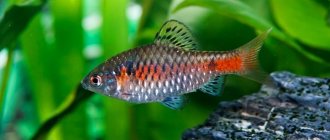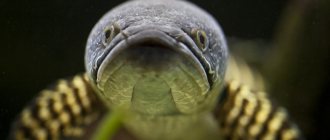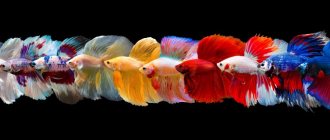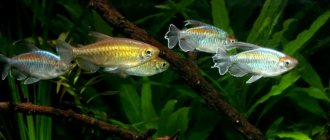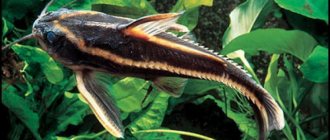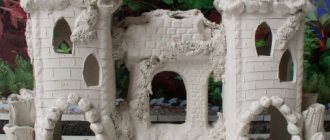Home › Aquarium fish ›
( 1 ratings, average: 5.00 out of 5)
Red Loricaria or Rhineloricaria sp. "Red") is a very attractive and unusual aquarium fish, freshwater chain catfish, belongs to the chain catfish family (Loricariidae) and is often designated L010a/L10a (L - loricariids). Sometimes red loricaria is also called red lizard or whiptail catfish, red lizard catfish.
Habitat in nature
Argentina and Venezuela are considered to be the birthplace of Otocinclus catfish. Some varieties of fish can be found in Brazil, Paraguay and Peru. Catfish can also be found in the Orinoco Basin and the upper Amazon.
Otocinclus inhabit small streams and clear rivers with gentle currents, where they eat algae and fouling at the bottom of watercourses. Catfish can usually be seen off the coast, where they hide in small-leaved plants. With the help of suction cups they cling to broad-leaved thickets, stones and other underwater objects.
Otocinclus live in flocks of several thousand individuals. Flocks graze in sandy shallow waters, where there are many plants and snags. Catfish feed on periphyton and algae.
Otocinclus live in small streams and clean rivers.
Description and natural habitat
In the wild, Loricariaceae are found in South and Central America. They are found in fresh water bodies rich in rotting wood and algae.
Chain catfish are popular due to their unusual appearance, namely bony scales. The length of the fish ranges from 2 to 50 cm. The color is predominantly dark. The head is large, covered with small teeth. The dorsal fin is long, and the caudal fin is branched with bony rays. Life expectancy under proper conditions is up to 8 years.
They are quite calm and non-aggressive. They love space, dig holes, hide from predators and spawn in shelters and holes during the rainy seasons. They spend most of their time at the bottom of reservoirs.
Catfish have an interesting oral apparatus - a sticky mouth, thanks to which they can scrape decaying organic matter from various surfaces.
Another feature is that fish have the ability to perform intestinal respiration, in which they can breathe air during the dry season, when the waters of the Amazon are not sufficiently saturated with oxygen.
For the most part, these are omnivorous species, but there are also obvious predators. Some lead a gregarious lifestyle, others are obvious loners. For any species, life takes place in the bottom layers of water areas.
Diet of catfish
Otocinclus constantly collect food for themselves using their oral sucker. In an aquarium, cleaners feed on microalgae and zooplankton, so cleaning the tank should not be done with chemicals that kill small organisms.
Since there is little necessary food for catfish in a container with renewed water, it is necessary to purchase additional complementary food for them. The fish can be fed with vegetable scraps and bread. Catfish especially love cucumbers , zucchini, zucchini and spinach. The products must first be soaked in clean water and only then immersed in the aquarium. Food that remains uneaten must be removed after 1-2 days so that it does not pollute the aquatic environment.
Otocinclus will happily eat dry plant food. Food rich in proteins is given to fish during the spawning period.
There will be little food for the otocinclus in the new aquarium, so you will need to prepare additional food.
Mr. Tail recommends: varieties
Scientific classifications of Chain catfish include about 7 subfamilies and more than 900 varieties, which have different colors and sizes.
The most common ones are:
| View | Subspecies | Description |
| Otocinclus | Zebra | Elongated body, covered with plates, uneven wave-like pattern. |
| Broadband, tape, vittatus | The color is gray-green or gray-brown with a black stripe along the body. | |
| Striped, macrospilus | There are small antennae on the muzzle. Like the rest of the species, it has intestinal respiration and has a flattened body. | |
| Simple | A small spotted fish 2-5 cm in length, has intestinal respiration. | |
| Ancistrus | Ordinary | The catfish is medium in size, about 10-15 cm, unpretentious, dark in color. |
| Common albino | Beige body, red eyes, has weak immunity. | |
| Yellow | Up to 8 cm long, yellow in color. | |
| Red | Grows up to 4 cm, the body is bright red. | |
| Star-shaped | It is about 9 cm in size and has an interesting color: completely black with small white dots. | |
| Pterygoplichthus | – | Large catfish up to 50 cm long. A distinctive feature is a very beautiful dorsal fin, similar to a fan, up to 15 cm. |
| Sturisoma | Panama | It differs from previous species in its slender, elongated body. |
| Golden | Large fish up to 20-30 cm in size. | |
| Festivum | It has long filaments on the caudal fin. | |
| Black-snout | Large black nose. | |
| Hypancistrus | Zebra | Characteristic striped black and white color. Size up to 10 cm, feeds on animal food. |
| Inspector | The body is dark in color with small light spots, the fins have white stripes and black edging. | |
| Contradence | Very similar to the previous subspecies, but has the same spotted fins as the body. | |
| Lunaorum | Dark body with white dots. | |
| Furunculus | Striped beige and black body. | |
| Debilitator | Wavy light and dark stripes. | |
| Loricaria | Peruvian, red | Reaches 18 cm, slender body red or olive in color. |
| Ordinary | Beige color with striped fins. | |
| Royal | Light in color with dark spots of various shapes. | |
| Numbered L-somas | L-181 | Black body with white stars, white fin edges. They love warm water. Dorsal fin with 8 rays. |
| L-183 | Dorsal fin with 9 rays. By the time the fish is 1 year old, the light edging of the fins disappears or becomes narrower. | |
| L-66 | About 15-18 cm in size. Picky catfish. Beautiful striped body, color changes as it grows. Their content is quite complex. | |
| L-091 (Leporacanthicus triactis) | It grows up to 30 cm, has a dark brown color with dark spots. The oral cavity is equipped with teeth. |
Large Loricariid catfish
The photo shows an aquarium with various representatives of the Loricariidae family. Sooner or later, every visitor to an aquarium store encounters sucker catfish, representatives of the Loricariidae family.
These fish are sold as indispensable algae killers. Loricariid or chain catfish, depending on the species, demonstrate differences in lifestyle, temperament, and body size (from 5 cm for Otocinclus affinis to the half-meter territorial giant Acanthicus). All sucker catfish live and look great in captivity, but beginners who receive them are sometimes horrified by the fact that in an average-sized container these “algae fighters” become larger and larger. There is often a situation where there are large adult catfish Hypostomus or leopard catfish Glyptoperichthys in the store, but there is no rush to buy them. Small species, no more than 3 cm long, on the contrary, are sold out much faster by aquarists who want to purchase a fish that fights algal fouling. The ideal option for keeping a mixed aquarium clean is a pair of Ancitrus or a group of Otocinclus, which are constantly busy eating algae from the plants, bottom and glass of the tank. On the other hand, people who are fascinated by giant loricariids and have at their disposal a large enough aquarium to keep one or more individuals will receive a long-lived, hardy and sometimes very beautiful pet.
All ringed catfish originate from South America, where strong fluctuations in water levels have led to a number of specific adaptations. During the rainy season, there is an abundance of food in the reservoir; it is during this period that catfish begin to reproduce. They spawn in burrows they dig or in natural crevices and holes. With the arrival of drought, life becomes more difficult. River floodplains dry out, leading to the formation of a number of isolated small puddles depleted of oxygen. Mainstream river inhabitants are also experiencing decreased oxygen levels due to slower flows. As an adaptation to these conditions, all large loricariids are able to breathe atmospheric air with varying degrees of efficiency. Air is stored in the intestine and absorbed by its walls, while metabolic products, including carbon dioxide, are removed through the anus and gills. If the water level in a puddle has dropped so much that the catfish can no longer stay in it, it moves along the ground to a new body of water. The thick skin of chain-mailed catfish allows individuals not to dry out for a long time, and the absorption of oxygen in the intestines and breathing of atmospheric air continues indefinitely. Using its pectoral fins, the fish can move overland over a short distance and, although many individuals never find shelter, some manage to colonize a new body of water. The catfish remaining in the drying puddle are the object of fishing for the aborigines, who use these fish for food.
Considering the fact that even a harsh habitat is not able to cope with representatives of this family, their undemandingness and resistance to the conditions created by novice aquarists is obvious. Currently, there is confusion regarding the naming of a specific species. Moreover, nomenclature is constantly changing not only for certain species, but also for entire families. Thus, the brocade plecostomus, known as Hypostomus plecostomus, was named by Gronovius as Plecostomus plecostomus in 1754, in 1758 representatives of the species were designated as Acipenser plecostomus. Today, the genus Acipenser includes only sturgeons, a group of fish that have dense lamellar skin, only superficially reminiscent of the integument of chain-mailed catfish. The generic name Hypostomus appeared after the discovery by Lacepede in 1803 of individuals of the species Hypostomus guacari, which, in fact, turned out to be a brocade plecostomus. The much smaller species Ancistrus cirrhosus began its taxonomy history under the generic name Hypostomus, while Glyptoperichthys gibbiceps was originally designated Ancistrus and Pterygoplichthys. As a result of all the innovations in nomenclature, even a loricariid enthusiast can find it difficult to keep up to date with the latest species names. To avoid confusion, species and variations imported from America are marked with the Latin letter L and a number. The full list of these commercial names remains a mystery to most aquarists.
Fortunately, large loricariids have similar conditions. All of them are omnivores, although there is a bias towards a vegetarian diet. The plant-based diet is supplemented with various types of frozen live food, or fresh sedentary food, for example, worms. It makes no sense to give loricariids small mobile insects and crustaceans, in particular daphnia. All vegetarians, including catfish, require more food by weight and produce more metabolic products than carnivorous species. Large catfish consume an impressive amount of food and produce a lot of waste, which only a powerful filtration system can handle. They all prefer an aquarium where there is a strong current and high levels of dissolved oxygen. In this case, a ground filter with a false bottom is not suitable, or is seen as just an addition, even if the aquarist is ready to spend his life constantly siphoning the ground. The main one should be an external canister apparatus. Since most loricariids are nocturnal animals, bright lighting during the day will minimize their locomotor activity. However, in dim light, many catfish will move quickly around the tank, especially if they are hungry. When choosing an aquarium, it is necessary to take into account that, despite the low activity of the fish, it is necessary to provide a volume in which to expand. The dense covers of catfish make them inflexible, therefore, if kept, for example, 60 cm, the fish will not feel well in a container 30 cm wide. It is much better to place it in a 90 cm2 aquarium than in a container 180 cm long and 30 cm wide. At the same time, the height is not matters because the catfish spends all its time at the bottom, never rises to the middle layers, and only occasionally swallows air from the surface. Caution must be exercised when ringed catfish are part of a public aquarium. Despite the fact that loricariids are rarely perceived by neighbors as a danger, or even as living beings, their approach, for example, to the spawning site of large cichlids, can lead to beatings. On the other hand, some chain catfish are aggressive. So, although Hypostomus is usually considered a peaceful fish, there are cases when it killed representatives neighboring it. Other species are more aggressive. One of the largest catfish, Acanthicus, in some cases, kills the victim with the spines of the interopercular bone, patiently waiting for it before doing so.
Many large loricariids can be kept in the aquarium, ranging from the unpretentious Hypostomus and Glyptopericthys to the exotic, beautiful and expensive Panaques and Acanthicus. An aquarist wishing to purchase a common Glyptopericthys will be able to do so for a reasonable fee even for a large specimen, while more exotic species will require more money and may only be available as fry.
Hypostomus sp.
While accurate identification of loricariids to the genus level is an accomplishment for most retailers, it is worth noting that not all brocade catfish are classified as Hypostomus plecostomus. There are dozens of species of Hypostomus, not all of which are likely to have an L-number. In fact, many of the changes that occur as fish grow older will make it difficult to accurately determine their species. Some of the catfish reach 60 cm in length, others grow no more than 30 cm. Most likely, such variability in body size is associated with the assignment of individuals to different species, but a significant part of buyers do not know what kind of fry they are purchasing, so this mystery will be revealed much later. There is information about different spawning behavior of brocade catfish. Thus, specimens imported to North America spawn by laying eggs on smooth rocks, while species grown in Florida dig holes in ponds. In particular, Hypostomus punctatus has been reported to lay eggs in a burrow formed by a piece of bog oak. Another unidentified pair spawned in PVC pipes, displaying a lengthy courtship display. Obviously, for most aquarists, the specifics of reproduction will not allow them to determine the species, because most of them will not be able to provide the conditions under which catfish will reach sexual maturity and begin to reproduce. Most hypostomuses are peaceful fish, but among them there are aggressive individuals with the unpleasant habit of hitting and rubbing their sides against their neighbors, thereby causing stress in the latter. They are a hardy and tolerant species, which explains their introduction into the waters of North America, where catfish show unpretentiousness to the pH and hardness of the water, provided that it is clean and rich in oxygen.
Hypostomus punctatus
Glyptoperichthys gibbiceps
The Leopard Brocade Catfish was finally assigned to the genus Glyptoperichthys in 1991, but for a long time had many names among aquarists. Individuals of this species are for the most part peaceful, although they can demonstrate territoriality when more than one individual is kept in a container. Catfish reach 50 cm in length, they are less hardy compared to representatives of Hypostomus. At the market, both juveniles and adult “refusers” of Glyptoperichthys gibbiceps are found everywhere. In Malaysia, pond breeding of these catfish has been established, where they spawn by digging deep holes.
Liposarcus sp.
Until the recent renewal of the genus Liposarcus, representatives of the species Liposarcus anisitsi and Liposarcus multiradiatus, together with Glyptoperichthys gibbiceps, belonged to the genus Pterygoplichthys. Both of these species are represented by peace-loving fish that reach very large sizes and are able to reproduce only in ponds. Liposarcus anisitsi, reaching a length of more than 60 cm, builds deep burrows at the bottom of the reservoir. The fish themselves do not even live in them outside the breeding season, and during the dry season they were photographed sitting in burrows that were high above the water level. L. multiradiatus has been reported to lay over 1000 eggs in a burrow 60 cm below the water surface. They are characterized by a very high dorsal fin and a peaceful disposition.
Panaque
This genus includes both large and small species of catfish. For hobbyists who do not have a large aquarium, Panaque gnomus, which reaches a length of only 6 cm, is perfect. On the other hand, the genus also has such giants as the 50 cm P. maccus, which is still sold under the name “dwarf clown plecostomus”. Representatives of Panaque differ from Peckoltias (clown plecostomus) by the presence of spoon-shaped teeth. However, in the future it is likely that some Panaque species will be transferred to another genus. A few Panaques catfish can be classified as large, although more often many large specimens are simply assigned to the species' L-number. Occasionally, fish similar to the King Panaque (P. nigrolineatus) are supplied under his number and reach 60 cm, although specimens of P. nigrolineatus are less than 30 cm in length. Juveniles of P. nigrolineatus are extremely attractive, their coloration includes a gray background with black horizontal stripes. In aquarium conditions, the maturation of these catfish leads to the disappearance of the stripes, however, large P. nigrolineatus, which have a charming, original color, have been caught in nature. Importing and purchasing king Panaque comes with a lot of risk because the arriving catfish experience extreme hunger and malnutrition. If individuals have a concave tummy, then even the most nutritious and refined diet is unlikely to save them from dystrophy. All members of the Panaque genus prefer water that is slightly acidic. They are sensitive to high nitrate levels, so regular water changes are required. Despite the fact that catfish are tolerant of representatives of other species, they are extremely territorial and jealously guard their area from conspecific individuals. One of the rarest catfish of this genus is Panaque suttoni or blue-eyed brocade catfish. Individuals of this species are about 30 cm long. Their natural population is catastrophically declining, and in captivity they do not reproduce.
Panaque nigrolineatus (wikipedia)
Panaque suttoni or blue-eyed brocade catfish (ill. www.arofanatics.com/forums/showthread.php?t=368314)
Acanthicus sp.
Acanthicus currently includes two species, A. hystrix and A. adonis. The maximum recorded length of Acanthicus hystrix was more than 80 cm, while A. adonis specimens typically reach a meter in length. Representatives of both species are simply amazing, they have, respectively, black and black with white spots (at least while young) coloring, and are covered with many spines, resembling living sculptures. Despite the fact that in the literature acanthicus are considered as aquarium fish, this is only true for experienced aquarists who can provide catfish with a spacious home. As juveniles, acanticus are very cute and beautiful creatures, but as adults they begin to show aggression, which, combined with the presence of spines, makes them dangerous neighbors for most fish. Acanthicus hystrix and Acanthicus adonis prefer soft, acidic water and are very hardy fish.
Skull of Acanthicus hystrix, Agassiz, 1829 (ill. Pavel Zuber).
An adult Acanthicus hystrix collected from the Rio Tocantins River near Estreito, Maranhão state, northern Brazil. © Adam Carvalho, seriouslyfish.com.
Burrows in the Rio Tocantins, where loricariids breed during the rainy season © Adam Carvalho, seriouslyfish.com.
Young Acanthicus adonis in an aquarium (ill. free-pet-wallpapers.com)
—— Kathy Jinkings www.tropicalfishfinder.co.uk/article_detail.asp?id=32 translation for
Breeding
It is necessary to prepare an insulator with a volume of at least 20 liters with fresh water, a temperature not lower than +18 ° C, ensure good filtration and aeration, and add plants with wide, hard leaves.
Loricariids are planted in the evening, the number of males is three times greater than the number of females. The eggs will appear in the morning. If this happens in a common aquarium, it is recommended to move the substrate into a separate container and calmly raise the fry there. In the first days, the fry feed on the yolk sac. When the cubs begin to swim, they are given complementary food - live dust and crustaceans.
Maintenance and care
To keep a small group of red loricaria, a 70 liter aquarium is recommended. An aquarium with a volume of 35 liters is sufficient for one individual. The bottom of the container should be covered with fine soil, preferably sand - these fish like to burrow into gravel.
Like most catfish, the red loricaria loves shelters and caves, so it is advisable to use properly pre-processed tree branches and roots, oval and smooth stones, dried leaves (oak, beech, alder), and alder cones as decorations. Tree branches drilled from the inside or plastic tubes are often used to create caves and shelters for catfish. Red Loricarias like a large number of plants in the aquarium and do not like too much light.
The water in the aquarium must be of good quality, clean and oxygenated, so it is advisable to have a good filtration system with a medium flow of water.
Water can be soft or medium hard, 2-15° gH. Acidic or slightly alkaline, pH 6.0-7.5. The temperature should be maintained at 24-29°C.
Aquarium Basics
For the comfortable life of the Chain Catfish, the following requirements for aquarium water must be observed:
- Blandness.
- The volume of the container is based on the type of catfish.
- High-quality filtration and aeration.
- Temperature +20…+26 °С.
- Hardness up to 10.
- Acidity up to 8.
- Weekly water change by 1/4 of the total volume.
They feed mainly on plant foods, algae, and can sometimes be fed with steamed vegetables. As aquarists age, they notice that their appetite increases.
It is not recommended to keep them with scaleless fish, as the catfish will injure them with their scales, as well as near cichlids and other large predators.
